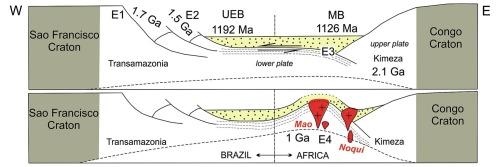Incipient formation of the African precursor basin to the Ediacaran-Cambrian Araçuaí − West Congo Orogen: Implications for Columbia breakup and Gondwana assembly
IF 7.2
1区 地球科学
Q1 GEOSCIENCES, MULTIDISCIPLINARY
引用次数: 0
Abstract
The Panafrican West Congo Belt (WCB) is part of the Ediacaran-Cambrian Araçuaí – West Congo Orogen (AWCO). The central part of the WCB is characterized by an ENE-verging fold-and-thrust belt with eastward decreasing deformation and metamorphic grade. It is underlain by c. 2.1 Ga Eburnean-aged rocks, that, in the study area (Lower Congo region, Democratic Republic of Congo, DRC), are represented by the Kimeza Basement Complex covered by the West Congo Supergroup. New mapping, field data, and detrital zircon chronology, constrain the maximum deposition of its basal Matadi Formation to c. 1.13 Ga. The previously considered basal Palabala Formation comprises mylonites derived from various protoliths from the underlying basement (Kimeza gneiss, Mpozo syenite), as well as Matadi metaquartzite, marking Palabala a tectono-structural unit between the Kimeza basement and Matadi Formation, giving rise to a revised lithostratigraphy. The Matadi Formation in the Lower Congo region is intruded by several (per)alkaline granites, such as the Noqui granite near Matadi and the Mao granite near Boma. New zircon U-Pb and Pb-Pb ages constrain these intrusions to c. 1.0 Ga (i.e. between 1008 ± 10 and 990 ± 10 Ma). We demonstrate that the Noqui peralkaline pluton, contrary to previous models, is unrelated to the adjacent Mpozo syenomonzonite for which we provide new ages of c. 1.95 to 1.99 Ga. The Kimeza basement that hosts the intrusions yielded a zircon Pb-Pb age of 2036 ± 8 Ma. Our data suggests a continuous supradetachment precursor basin to the AWCO, comprising the Brazilian Espinhaço (west) and Matadi deposits (east). Overstretching of the basement produced the (per)alkaline intrusions described here and corresponds to one of the successive extensional events (“E4”) that marks the protracted Columbia breakup history, preceding the building of the AWCO during Gondwana assembly.

埃迪卡拉-寒武纪非洲前体盆地的早期形成Araçuaí−西刚果造山带:对哥伦比亚分裂和冈瓦纳组合的启示
泛非西刚果带(WCB)是埃迪卡拉-寒武纪Araçuaí -西刚果造山带(AWCO)的一部分。西断带中部发育东向褶皱冲断带,变形和变质程度向东递减。研究区(刚果民主共和国下刚果地区)以西刚果超群覆盖的基梅扎基底杂岩为代表,下布隆纳年龄约2.1 Ga。新的填图、野外资料和碎屑锆石年代学,限制了其基底Matadi组的最大沉积时间为约1.13 Ga。先前认为的基底Palabala组包括来自基底(Kimeza片麻岩,Mpozo正长岩)的各种原岩衍生的糜伦岩,以及Matadi变质石英岩,标志着Palabala是Kimeza基底和Matadi组之间的构造-构造单元,从而产生了修正的岩石地层学。下刚果地区的Matadi组被几种碱性花岗岩侵入,如Matadi附近的Noqui花岗岩和Boma附近的Mao花岗岩。新的锆石U-Pb和Pb-Pb年龄限制了这些侵入物在1.0 Ga(即1008±10和990±10 Ma之间)。我们证明,与以往的模式相反,诺基过碱性岩体与邻近的Mpozo同长岩无关,我们给出了c. 1.95 - 1.99 Ga的新时代。Kimeza基底的锆石Pb-Pb年龄为2036±8 Ma。我们的数据表明AWCO是一个连续的上滑脱前体盆地,包括巴西espinhao(西部)和Matadi(东部)矿床。基底的过度伸展产生了本文所描述的碱性侵入,并对应于连续的伸展事件之一(“E4”),该事件标志着哥伦比亚断裂的漫长历史,在冈瓦纳组装期间形成AWCO之前。
本文章由计算机程序翻译,如有差异,请以英文原文为准。
求助全文
约1分钟内获得全文
求助全文
来源期刊

Gondwana Research
地学-地球科学综合
CiteScore
12.90
自引率
6.60%
发文量
298
审稿时长
65 days
期刊介绍:
Gondwana Research (GR) is an International Journal aimed to promote high quality research publications on all topics related to solid Earth, particularly with reference to the origin and evolution of continents, continental assemblies and their resources. GR is an "all earth science" journal with no restrictions on geological time, terrane or theme and covers a wide spectrum of topics in geosciences such as geology, geomorphology, palaeontology, structure, petrology, geochemistry, stable isotopes, geochronology, economic geology, exploration geology, engineering geology, geophysics, and environmental geology among other themes, and provides an appropriate forum to integrate studies from different disciplines and different terrains. In addition to regular articles and thematic issues, the journal invites high profile state-of-the-art reviews on thrust area topics for its column, ''GR FOCUS''. Focus articles include short biographies and photographs of the authors. Short articles (within ten printed pages) for rapid publication reporting important discoveries or innovative models of global interest will be considered under the category ''GR LETTERS''.
 求助内容:
求助内容: 应助结果提醒方式:
应助结果提醒方式:


